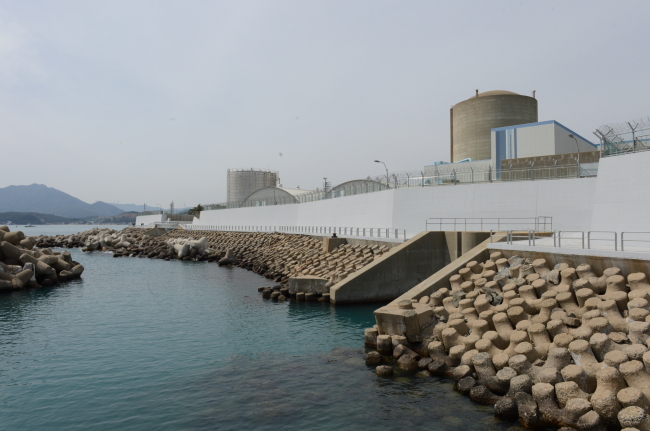KHNP tightens safety for nuclear plants
Measures include higher sea walls, more earthquake protection
By Korea HeraldPublished : March 4, 2014 - 20:35

State-run Korea Hydro and Nuclear Power Co., the sole operator of the nation’s 23 nuclear reactors, said Tuesday that it would invest 1.1 trillion won ($1 billion) by 2015 to beef up safety measures.
The KHNP has made all-out efforts to ensure the safety of power plants across the nation ever since Japan’s Fukushima nuclear disaster in 2011.
In the latest developments, the company said it would hold a workshop Wednesday to raise awareness of nuclear energy safety under the theme “Lessons from Fukushima ― We will not forget.”
During the meeting, KHMP will announce a nuclear industry safety charter with other corporate players in the sector.
All attendees will discuss a wide range of issues including transparent management of power plants and communication with the public. KHNP officials will give presentations on safety measures deployed by the firm after Fukushima.
“The KHNP will try to make the nuclear power plants in Korea the safest by buttressing safety measures for possible earthquakes and tsunamis,” an official from the company said.
One of the firm’s safety measures is installing a control system that can withstand a magnitude-7.0 earthquake and safely stop operations when a nuclear plant is damaged by natural disasters.
The state-run company built a seawall in 2012 that measures 10 meters in height, 1.85 meters in thickness, and 2.1 kilometers in length around the Kori nuclear plants on the outskirts of Busan.
The company said that around 24,800 cubic centimeters and 600 tons of iron bars were used for the construction of the seawall.
Installed on the southern side of the seawall, a 10-meter-high, 800-centimeter-thick water gate closes as soon as a tsunami warning is initiated to prevent seawater from flooding the plant.
The water gate will be replaced with a new one fitted with beefed up water resistance technology, according to the firm.
Korea’s nuclear power plants utilize pressurized water reactors, different from boiling water reactors commonly used in Japan. PWRs are evaluated as much safer than the BWRs.
At a power plant with PWRs, coolant in the nuclear reactor is completely separated from the steam that runs the turbines, effectively preventing any possible leaks of radioactive substances.
Containers in PWR power plants are five times bigger than the ones used for BWR-based nuclear plants, which can allow more time for power plant operators to respond to the increase of pressure inside the container.
Waterproof drain pumps will also be installed in all nuclear power plants in Korea, the company said.
In preparation for urgent situations such as the malfunction of emergency diesel generators at a nuclear plant, 3,200-kilowatt―class movable power generators mounted on the back of trucks are being deployed to power plants.
By Kim Young-won (wone0102@heraldcorp.com)
The KHNP has made all-out efforts to ensure the safety of power plants across the nation ever since Japan’s Fukushima nuclear disaster in 2011.
In the latest developments, the company said it would hold a workshop Wednesday to raise awareness of nuclear energy safety under the theme “Lessons from Fukushima ― We will not forget.”
During the meeting, KHMP will announce a nuclear industry safety charter with other corporate players in the sector.
All attendees will discuss a wide range of issues including transparent management of power plants and communication with the public. KHNP officials will give presentations on safety measures deployed by the firm after Fukushima.
“The KHNP will try to make the nuclear power plants in Korea the safest by buttressing safety measures for possible earthquakes and tsunamis,” an official from the company said.
One of the firm’s safety measures is installing a control system that can withstand a magnitude-7.0 earthquake and safely stop operations when a nuclear plant is damaged by natural disasters.
The state-run company built a seawall in 2012 that measures 10 meters in height, 1.85 meters in thickness, and 2.1 kilometers in length around the Kori nuclear plants on the outskirts of Busan.
The company said that around 24,800 cubic centimeters and 600 tons of iron bars were used for the construction of the seawall.
Installed on the southern side of the seawall, a 10-meter-high, 800-centimeter-thick water gate closes as soon as a tsunami warning is initiated to prevent seawater from flooding the plant.
The water gate will be replaced with a new one fitted with beefed up water resistance technology, according to the firm.
Korea’s nuclear power plants utilize pressurized water reactors, different from boiling water reactors commonly used in Japan. PWRs are evaluated as much safer than the BWRs.
At a power plant with PWRs, coolant in the nuclear reactor is completely separated from the steam that runs the turbines, effectively preventing any possible leaks of radioactive substances.
Containers in PWR power plants are five times bigger than the ones used for BWR-based nuclear plants, which can allow more time for power plant operators to respond to the increase of pressure inside the container.
Waterproof drain pumps will also be installed in all nuclear power plants in Korea, the company said.
In preparation for urgent situations such as the malfunction of emergency diesel generators at a nuclear plant, 3,200-kilowatt―class movable power generators mounted on the back of trucks are being deployed to power plants.
By Kim Young-won (wone0102@heraldcorp.com)
-
Articles by Korea Herald







![[Hello India] Hyundai Motor vows to boost 'clean mobility' in India](http://res.heraldm.com/phpwas/restmb_idxmake.php?idx=644&simg=/content/image/2024/04/25/20240425050672_0.jpg&u=)











